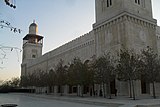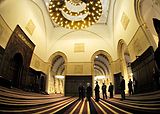King Hussein Mosque
King Hussein Mosque was built in 2005 in the reign of King Abdullah II of Jordan in West Amman, specifically in Al Hussein Public Parks at King Abdullah II Street near King Hussein Medical Center. The mosque is located at an altitude of 1,013 metres (3,323 ft) above sea level and can thus be seen from most parts of Amman. It is square and features four minarets and marble floors.
Prophet Mohammad Museum
The Prophet Mohammad Museum (Arabic: متحف النبي محمد, romanized: Mutḥaf al-Nabī Muḥammad) is a museum about Mohammad located in the King Hussein Mosque. The museum was opened on 15 May 2012, with King Abdullah II officiating.
The museum includes some of Mohammad's belongings, including a single hair from his beard, his letter to the emperor of Byzantium, in which he urged him to convert to Islam, and the sapling of the Sahabi Tree, a tree in the Jordanian desert where a tradition says Muhammad rested under it.
Gallery
-
King Hussein Mosque, outside view
-
King Hussein Mosque, outside view
-
King Hussein Mosque, outside view
-
King Hussein Mosque, outside view
-
King Hussein Mosque, entrance
-
King Hussein Mosque, main building
-
King Hussein Mosque, inside view
-
The King Hussein mosque at night, as seen from a balcony in West Amman.
References
- ^ "مسجد الملك حسين في عمان". الدستور (in Arabic). 25 July 2013. Retrieved 3 October 2018.
- ^ "Jordan - Touristic Sites - Amman". www.kinghussein.gov.jo. Retrieved 2019-01-03.
- ^ "King opens Prophet Museum in Amman". Jordan News Agency (PETRA). 15 May 2012. Archived from the original on March 4, 2016. Retrieved 2 February 2019.
- ^ "ملك يفتتح متحف الرسول صلى الله عليه وسلم في عمان". الغد. Retrieved 3 May 2018.







